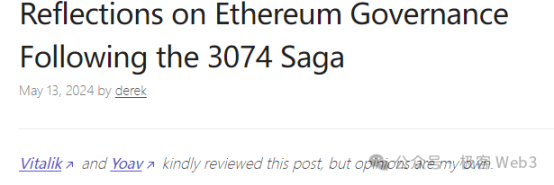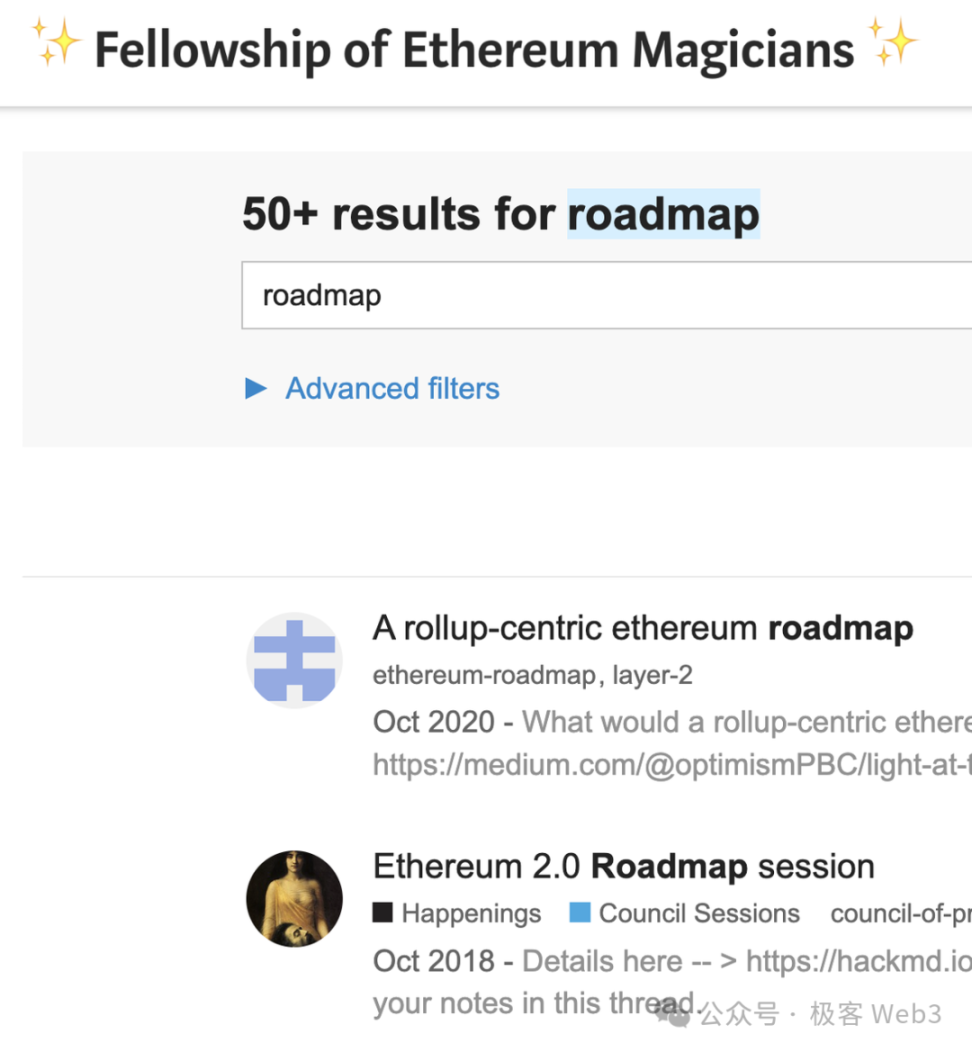原文文章,作者:Derek Jiang,ZeroDev 首席執行官
原文翻譯:《浮士德》、Geekweb3
摘要:本文是在 Vitalik Buterin 提出 EIP-7702 以平衡 ERC-4337 和 EIP-3074 之間的矛盾後,ZeroDev CEO Derek Jiang 對此事的看法。文章結合AA生態中一位專案創始人的個人經歷,客觀地指出了以太坊目前的治理模式和痛點,並指出:
以太坊的各種治理衝突之一是研究人員確定的路線圖與 Geth 等客戶端開發團隊的觀點不一致,Vitalik 以類似於 CTO 的身份成為最終決策者。
在對Vitalik的角色給予正面評價後,Derek指出了以太坊在治理模式上應該做出哪些改進,這對以太坊社群和比特幣社群都具有很大的參考意義。
內容:如果你之前不了解以太坊AA(Account Abstraction),這裡簡單回顧一下:
幾週前,EIP-3074提案獲得了以太坊核心開發者的批准,並將包含在下一個硬分叉Pectra中。該提案將為 EVM 帶來兩個新的操作碼,為以太坊 EOA 帳戶提供近乎原生的 AA 體驗。
此後,ERC-4337社群的許多人,尤其是4337的提案者,一直強烈反對EIP-3074,理由是擔心該提案會帶來許多安全風險,並且與以太坊的AA路線圖不相容。在以太坊之前的路線圖中,明確指出ERC-4337和類似的提案7560(也稱為nativeAA)是核心。
5月初,Vitalik提出EIP-7702作為EIP-3074的替代品,在4337和3074之間取得平衡——它可以為EOA用戶帶來AA體驗,但以一種更兼容ERC-4337和兼容ERC-4337的方式AA 最終解決方案 7560。
目前,以太坊核心開發人員正在考慮 EIP-7702。目前的初步討論結果和社群情緒顯示EIP-7702很可能取代上述EIP-3074。
就我個人而言,我對這個結果非常滿意:EOA 用戶很快就能體驗 ERC-4337 生態內的各種產品,並享受 AA 的大部分好處。然而,我不禁覺得有更好的方法可以實現上述結果,這在過去幾週很多人都指出了。我覺得如果有更好的治理流程,我們本來可以節省很多精力,更快達到預期的結果。
在這篇文章中,我想:
-
找出治理過程中出了什麼問題
-
提出思考以太坊治理的思維模型
-
提供改進建議,避免未來發生類似治理事件
EIP-3074事件的總結與反思
上述的故事讓很多人不高興,原因如下:
EIP-3074 花了數年時間才獲得批准。 3074最終獲得批准後,以太坊核心開發者面臨4337社群的強烈反對。
另一方面,ERC-4337的作者多次向以太坊核心團隊表達了對EIP-3074的擔憂,但沒有結果。現在以太坊正計劃取消3074的批准,並用另一個EIP(7702)代替。
上述任何過程都沒有本質上的錯誤:
-
關於生態工業園區的討論可能需要幾年時間,這很正常。
-
EIP獲得批准後被拒絕是很正常的。
-
生態工業園區獲得批准後,如果發現新問題,可以撤銷批准。
然而,事情本來可以順利得多。讓我們想像一下事情是這樣發展的:
在討論3074時,4337社群與以太坊核心開發者積極互動。如果這個前提成立,那麼只有兩種可能的結果:
-
在考慮了 4337 社群的回饋後,提案 3074 獲得批准(並且可能會被修改),在這種情況下,4337 社群將接受 3074,以太坊核心團隊將不必撤回 3074。
-
或者,也許 3074 從未獲得批准,但 4337 社區和以太坊核心團隊共同提出了一個令所有人滿意的提案,就像 7702 一樣。
所有人的聲音都被聽到了,並沒有出現戲劇性的反轉。那就太好了——那為什麼不呢?
出了什麼問題?
回顧整個過程,雙方都在互相指責。
以太坊核心開發者(以及EIP-3074 的作者)認為,這是4337 個支持者的錯,因為他們沒有積極參與所有核心開發者(ACD)的討論過程,在這個過程中,EIP 在被接受和在實施之前經過了長時間的審議。
有人認為,4,337名支持者本來可以在3074提案審議期間參與並發表意見,而不是等到3074獲得批准。畢竟,整個 ACD 流程都有詳細記錄,會議向所有人開放,像 Tim Beiko 這樣的人會在每次 ACD 會議後積極發布摘要推文。那麼,如果4337支持者如此關心這個主題,為什麼不積極、及時地參加相關會議呢?
另一方面,4337的核心成員指出,他們一直在參加ACD會議,並盡可能反對3074,但以太坊核心開發人員沒有聽。至於4337社區成員,大多數人都覺得很突然──很多人都以為3074已經死了,甚至不知道3074很可能會被批准。
許多人指出,ACD會議的整個過程並不透明,對於那些認真在以太坊社群卻無法及時跟上ACD更新進度的人來說並不友善。也有人認為,ACD 應該主動尋求利害關係人(這裡指 4337 社群)的回饋。
然而,我認為雙方都沒有抓到重點。這背後還有更深層的問題,除非我們正視或至少承認這個問題,否則治理事故就會不斷發生,雙方互相指責,這是沒有意義的。
解決事件的根本原因:路線圖
與普遍看法相反,治理事件的根本原因是ACD並不是以太坊協議更新的唯一治理權力來源,而是被另一個治理權力來源所取代。這裡的問題是,儘管其他治理權力在以太坊核心問題(例如 AA 和可擴展性)上比 ACD 具有更大的影響力,但很少被承認。
在本文中,我將這種力量稱為「路線圖」。
正如我將在下面指出的,整個 3074-4337-7702 治理失敗事件是以太坊現有路線圖的力量凌駕於 ACD 的力量的一個案例。如果我們談論治理,當我們注意到有一種無形的力量壓倒了有形的力量時,我們應該對此感到極度擔憂,因為無形的東西往往很難解釋,也無法被太多人注意到,所以它們必須被裸露。
什麼是路線圖?
以太坊社群中的任何人一定經常看到「路線圖」這個術語,例如在「以 Rollup 為中心的路線圖」、「ETH 2.0 路線圖」或本例中的「AA 路線圖」中。
為了說明我的觀點,讓我們想像一下 ACD 會議的場景,核心開發人員正在討論如何擴展以太坊:
-
核心開發者Bob:我支援EIP-1234,它提出我們將出塊速度提高10倍,將區塊大小增加10倍,將費用降低100倍。
-
其他核心開發人員:……你瘋了嗎?
讓我們想一想。為什麼以太坊核心團隊拒絕了Bob的說法?他只是提出了一個非常合理的擴容方式。 Solana、Aptos、Sui等很多公鏈都這麼做了,而且取得了很高的TPS。
原因是這個虛構的EIP-1234違反了以太坊以rollup為中心的擴展路線圖,該路線圖指出,對於去中心化而言,普通用戶能夠以低成本運行節點至關重要。因此,虛構的EIP-1234不能被接受,因為它會大幅增加運行以太坊節點的成本。
我想用這個例子來說明,參與ACD治理流程並決定協議更新的核心開發人員是受到更高級別力量的指導,我稱之為路線圖。目前有擴容路線圖、AA路線圖、MEV路線圖等,它們共同構成了以太坊的整體路線圖,核心開發者必須根據此做出決策。
當核心開發人員的意見與路線圖不一致時
由於路線圖不是以太坊治理流程的正式部分,因此通常無法保證核心團隊會遵守路線圖。此外,沒有正式的路線圖批准程序,因此並非所有路線圖都具有相同的合法性。以太坊路線圖背後的研究人員必須努力向核心開發者和社群推廣他們的路線圖,以獲得合法性,從而獲得以太坊核心開發團隊的支持。
就AA和帳戶抽象而言,Vitalik本人曾多次推動以4337為中心的AA路線圖,但總體而言主要是4337背後的團隊,尤其是Yoav和Dror,他們主張以4337為中心的AA論壇和ACD 會議中的路線圖。
然而,儘管做出了這些努力,一些以太坊核心開發者仍然強烈反對以4337 為中心的AA 路線圖。可行的解決方案AA 最終確定性。最終,ACD決定批准3074提案,儘管遭到了4337團隊的反對,他們認為3074會分裂整個AA生態。
3074獲批後,整個4337社群反應強烈,迫使以太坊核心開發者重新投入到3074的討論中。 -7702作為3074的替代方案,明確相容於以4337為中心的AA殘局,從而解決了衝突,使最終結果符合AA路線圖。
Vitalik 的角色:以太坊事實上的 CTO
儘管 Vitalik 將自己描述為研究員,但上述故事清楚地表明,Vitalik 擁有與其他研究人員截然不同的治理權力。那麼問題來了:Vitalik 在以太坊治理中扮演什麼角色?
就我個人而言,我認為將 Vitalik 視為一家非常非常大的公司的首席技術官可能是可以的(順便說一句,出於上下文考慮,假設以太坊“公司”沒有首席執行官)
如果您曾經在一家擁有超過 50 名員工的科技公司工作過,您就會知道 CTO 不可能參與每項技術決策。當公司達到一定規模時,各種技術解決方案的決策過程必須變得去中心化——通常公司產品/業務的每個領域都有專門的團隊,這個團隊通常可以自由決定解決方案的細節。
此外,CTO 不一定是所有(或任何)主題的領先專家。公司裡可能有工程師在特定領域比CTO更優秀,所以在討論技術細節時,往往是個別工程師做出最終決定。
然而,首席技術長為公司設定了技術願景。願景的執行留給了開發人員。
雖然這不是一個完美的類比,但我認為它合理地總結了 Vitalik 在以太坊生態系統中的角色。 Vitalik 並不參與每項技術決策,他也無法參與。他並不是每個領域的頂尖專家。但他對以太坊所有關鍵解決方案(擴容、AA、POS…)的路線圖有著壓倒性的影響力,不僅是因為他的技術專長,還因為他是路線圖是否符合以太坊願景的最終評判者(他的願景)。
每個成功的產品都始於一個願景
如果我認為 Vitalik 是以太坊的 CTO 還沒有引起足夠的爭議,那麼最有爭議的部分來了:我們應該接受 Vitalik 作為 CTO。
身為新創公司創辦人,我相信每個成功的產品背後都必須有一個連貫的長期願景——是的,以太坊是一個產品,因為它為真正的用戶解決了真正的問題。連貫的願景必須由少數人制定,例如新創公司的創辦人,而且通常只有一位創辦人。
以太坊的美妙之處在於,儘管它是一個非常複雜的系統,擁有如此多的組件,但這些組件完美地組合在一起,形成了一台運轉良好的去中心化計算機,每天可以處理價值數十億美元的交易。
我們今天聚集在這裡並不是因為某些委員會的計劃,而是因為 Vitalik 富有遠見的領導,我們能夠建立今天連貫而美麗的以太坊。以太坊是 Vitalik 在 2015 年提出的想法,至今仍然如此。
當然,這並不是要低估其他研究人員和工程師的貢獻,他們為以太坊的今天做出了巨大貢獻。然而,這並不矛盾,因為以太坊是 Vitalik 願景的實現,比其他任何人的願景都要大幾個數量級。
老實說,你能抱怨這個嗎?當您被以太坊生態系統的開放性、審查制度和創新速度所吸引時,您是否從 Vitalik 的願景開始抱怨它?也許你沒有抱怨是因為你沒有那樣想——但現在你抱怨了,但你真的介意這個問題嗎?
如何解決去中心化問題?
但是,你說,去中心化怎麼樣?如果一個人對以太坊擁有如此壓倒性的權力,我們怎麼能說它是去中心化的呢?
要回答這個問題,我們必須回到Vitalik寫的這篇關於去中心化意義的經典文章。這篇文章的主要觀點是,權力下放分為三種:
-
架構去中心化:系統停止運作之前必須有多少個節點發生故障?
-
邏輯去中心化:系統的各個子系統能否獨立發展,同時仍允許整個系統正常運行,還是必須緊密協調?
-
政治分權:有多少人或組織最終控制這個系統?
基於這些定義,以太坊在架構上顯然是去中心化的,也可以說,由於其元件(例如共識層和執行層)之間缺乏強耦合,它在邏輯上也是去中心化的。
就政治去中心化而言,好消息是沒有任何個人或組織可以關閉以太坊,甚至 Vitalik 也不能。然而,有人可能會說,以太坊並不像人們想像的那樣在政治上去中心化,因為 Vitalik 在製定以太坊的願景和路線圖方面發揮了重要作用。
然而,我認為如果我們希望以太坊繼續創新,我們就必須接受 Vitalik 作為事實上的 CTO,即使這意味著犧牲一些政治權力下放。
如果以太坊真的像比特幣一樣僵化為幾乎不可變的區塊鏈,那麼 Vitalik 可能就會退休。但在到達最後一步之前,至關重要的是要有一個各方都尊重、值得信賴的權威機構,能夠對技術決策做出判斷,不僅基於所提出的技術方案是否優越,還基於這些決策是否合理。
沒有 Vitalik,只有兩種可能的結果,而圍繞 3074 的故事生動地說明了這兩種結果:
-
以太坊治理流程可能會陷入無休止的僵局,雙方都不願意妥協,也沒有人能夠取得進展,正如在 Vitalik 介入之前陷入僵局的 3074 辯論所證明的那樣。
-
或者,以太坊可能會成為設計不連貫的科學怪人。前面提到的3074和4337可能不會互相屈服,最終AA生態系將徹底分裂成兩個互不相容的平行空間。
社區的作用
經過上述思考,我們已經接近勾勒出一個完整的以太坊治理思維模型了,但到目前為止我們的討論中有一個明顯的遺漏——社群。
如果Vitalik定義了以太坊的願景,研究人員定義了路線圖,核心開發人員實現了路線圖,那麼社群的角色是什麼?肯定不是什麼都沒有吧?
幸運的是,社區實際上扮演著最重要的角色。原因在於,先有願景,才有價值觀。我們作為一個社區聚集在一起,因為我們圍繞著某些價值觀團結在一起,而 Vitalik 的願景最終必須與這些價值觀保持一致,否則它將失去社區的支持。
以太坊社群的所有人都相信,擁有一台人人都可以存取、抗審查且值得信賴的去中心化電腦對世界有好處。我們每天透過在以太坊上所做的工作來維護和確認這些價值觀,並以此為 Vitalik、研究人員和核心開發人員設定的願景、路線圖和程式碼提供合法性。
以太坊治理的 VVRC 模型
所以這是以太坊治理的完整心智模型,價值觀⇒願景⇒路線圖⇒客戶,簡稱VVRC:
-
V==價值觀==社群;
-
V==願景==Vitalik;
-
R==路線圖==研究人員;
-
C==客戶端==核心開發人員;
它們共同執行以下功能:
-
社區圍繞著某些價值觀凝聚在一起。
-
Vitalik 表達了與這些價值觀一致的願景。
-
研究人員根據願景制定路線圖。
-
核心開發人員根據路線圖實現客戶端。
當然,現實比任何簡單模型所能捕捉到的要複雜得多。事實上,以太坊核心開發人員是唯一可以透過更改客戶端程式碼來真正對任何提案進行投票的人。 Vitalik 等研究人員只起到諮詢作用,有時他們的意見並不被核心開發者接受,這也是 EIP-3074 獲得批准的原因。
話雖這麼說,我認為 VVRC 模型合理地捕捉了以太坊治理模型在正常情況下的運作方式,我們需要「調試」該過程,以免再次發生像 EIP-3074 那樣的情況。
如何改善以太坊的治理模式
現在我們已經有了以太坊治理流程如何運作的心智模型,這裡有一些改進它的想法。
-
必須提高正在審議的生態產業園討論進展的可見性。整個社區不應該對 EIP 被接受感到驚訝,像 3074 這樣令人驚訝的提案不應該再出現。
EIP 網站上的目前 EIP 狀態並不反映其在 ACD 流程中的狀態。這就是為什麼它仍然說 3074 處於審核中狀態,儘管核心開發人員已經投票批准了它,並且沒有跡象表明它一開始就被考慮過批准。
理想情況下,當 EIP 即將被接受時,以太坊基金會將在社交媒體上響亮而清晰地宣布,以提高社區的認識。
-
有時核心開發者可能會低估某個特定EIP對下游項目和用戶的影響,社區3074和4337就是這種情況。說話。
話雖如此,偶爾分配一些發言時間讓社區成員評論某些 EIP 提案(如果這些提案獲得通過)的下游影響是有意義的。
如果研究人員認為他們的觀點沒有被核心開發者接受,就像 4337 的情況一樣,他們可以讓社群成員參與進來來強化他們的主張。
-
至關重要的是,核心開發人員和研究人員認識到彼此是以太坊治理權力的一部分,儘管他們的權力水平不同。核心開發人員對以太坊客戶端進行更改和更新的權力是唯一可以「投票」對協議本身進行更改的權力。由於研究人員積極談論和撰寫他們的想法,研究人員對路線圖進行更改和解釋的權力往往會得到更多的公眾支持。
當這兩種力量發生衝突時,核心開發人員可能會傾向於簡單地否決研究人員,就像核心開發人員否決4337團隊的反對意見一樣。衝突時會變得不穩定,正如3074獲得批准後發生的戲劇性事件所示。
同樣,當面臨阻力時,研究人員可能會試圖放棄與核心開發人員的合作,在我看來,這是創建RIP 流程的原因之一,也是為什麼原生AA (7560) 現在主要作為RIP 而不是EIP 進行推廣。
雖然在 L2 上嘗試協議更新確實有好處,但在 L1 上有爭議,但我們不能將 RIP 視為參與 EIP 治理流程的替代品。研究人員必須繼續與核心開發人員合作,直到雙方的價值觀與路線圖完全一致。
綜上所述
3074/7702事件揭示了以太坊治理的真正運作方式——除了核心開發人員驅動的EIP/ACD流程的顯性治理權力之外,還有研究人員驅動的路線圖的隱性治理權力。當這些力量錯位時,我們會看到僵局和鞭打,可能需要另一種力量——維塔利克——以某種方式打破平衡。
然後我們提出,Vitalik 代表了一種獨特的力量,即以太坊的“願景”,它是任何路線圖合法性的基礎。我們將 Vitalik 比作一家大公司的 CTO,並承認他作為偽 CTO 的角色對於以太坊保持創新步伐是必要的,這可以防止以太坊退化為「科學怪人」般的拼湊怪物。
最後,我們提出了一個描述以太坊治理模型的 VVRC 模型:價值觀(社群)⇒ 願景(Vitalik)⇒ 路線圖(研究人員)⇒ 客戶(核心開發人員)。然後我們提出了各種方法來修復該模型的錯誤。
以太坊治理是製造機器的機器──為了讓以太坊正常運轉,我們必須有合理的治理。因此,3074為治理事故提供了一個有價值的案例,希望以太坊社群能夠從中吸取一些有益的教訓,以完善未來的以太坊治理流程。
本文源自網路:論Vitalik及各種路線圖對以太坊治理流程的影響
相關:SignalPlus宏觀分析(20240506):風險資產有機會再次開始緩慢攀升
今年首次就業數據低於預期(沒有意外增加),整體就業變化+175,000(此前平均增幅在275,000左右),失業率也意外從3.83%上升至3.87% 。其他高頻就業市場指標也開始顯示出放緩的跡象,例如最近的 JOLTS 報告顯示,職缺與失業人員的比例較低,私部門的招聘和離職人數處於多年低點。此外,小型企業的招聘趨勢顯著減弱,ISM和PMI的就業成分均顯示疲軟,服務業和製造業企業的招聘比例下降至經濟衰退時常見的水平。上週五,我們指出非農就業數據更有可能...












